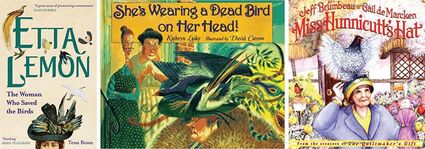A feather in your cap?
The TALE: Tehachapi Art, Literature and Entertainment
March 19, 2022
Recently there was a kerfuffle on the show “Wheel of Fortune,” when contestants stumbled over the phrase, “Another feather in your cap.” Eventually the puzzle was solved, after a series of wrong guesses. This made me wonder about the phrase. Where did it come from? What does it mean? Why had it been so hard to figure out? Of course, I had to do some research!
Apparently this term arose in several cultures independently. In the 1550s, the noblewoman and Duchess of Florence, Eleanor Toledo, wore peacock feathers in her hat to protect herself from the rain. Hungarians in a 1599 battle wore feathers to represent how many Turks they killed in war. Native American feather head-dresses were worn by warriors to represent their bravery. An 18th century Duchess of Portland used a twist of the phrase “feather in his hat.” And then of course, there is the children’s rhyme of Yankee Doodle Dandy riding a pony with a feather in his cap that he called macaroni. This rhyme also became the theme and well-known song from James Cagney in the 1942 patriotic movie of the same name, “Yankee Doodle Dandy.” A feather in the cap was generally a symbol of achievement. Who knew feathers have been so popular for such a long time.
Through centuries, people have believed that feathers bring spiritual messages and prayers from the heavens, with white feathers symbolizing an angel message from above and a black feather keeping away evil and negativity. Gray feathers represent balance between opposing forces, blue feathers nudging one toward action and acceptance. And yellow feathers bring happiness with a message to slow down and enjoy life.
Have you ever looked down and found a feather at your feet? Or watched a feather floating in the wind and been caught up in the desire to believe you were receiving a message?
Unfortunately there is a dark history about feathers as well. During the same time women were fighting for the right to vote, another woman battled for 50 years to stop the use of feathers in hats.
In “Etta Lemon, the Woman Who Saved the Birds” by Tessa Boase, the reader follows the true and both shocking and beautiful story of how one woman brought a dastardly plight of birds to world attention. What started as a fashion trend in the 1800s with a few feathers in ladies’ hats, turned into a travesty of slaughter as women pursued the position of wearing the most rare and unique feathers, and eventually whole dead birds were incorporated into the design of their elegant and extravagant headwear. Bird lovers and preservationists were in an uproar over the complete obliteration of rare and dying species. What was profitable in the business of milliners was devastating to nature.

If the descriptions in the Etta Lemon book are too distressing for some to handle, the story is also found in a gentler, kinder picture book titled, “She’s Wearing a Dead Bird on Her Head!” by Kathryn Lasky and illustrated with humor by David Catrow. It is a fictional story of Harriet Hemenway and her cousin Minna Hall who, as bird lovers, are incensed by the latest craze from feathers to whole birds on hats, and work through the Audubon Society in 1896 to lobby for laws to protect wildfowl.
In actuality, the Migratory Bird Act of 1918 is in effect to this day. It protects birds in our country from ever being decimated again. For years it has been against the law for people to even collect fallen feathers or egg shells in their yards, let alone wear real feathers in their hats, because of the egregious acts committed in the 19th and 20th centuries. The only exceptions are for scientific and educational pursuits, and for the religious purposes of the American Indian tribes. Other countries have their own protective laws.
So maybe the contestants on “Wheel of Fortune” can be forgiven for not immediately knowing the phrase, “Another feather in your cap” as real feathers on caps and hats were outlawed decades ago. For a little extra fun you might want to read an alternative story “Miss Hunnicutt’s Hat” by Jeff Brumbeau. I don’t want to spoil the story, but it does involve a queen, a small town, small minds and a live chicken, as well as a hat. This book is a study on tolerance and being free to be yourself. But a live chicken? Really? Though not illegal, sensibility might be called upon or considerable personal consequences may ensue!
Good books.
Good reading.
*Midge Lyn’dee is a fictional character used for the purpose of entertainment though the reviews are real and sincere.




